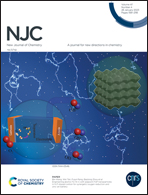Aggregation assisted turn-on response of ANS dye towards protamine†
Abstract
Protamine, a polycationic peptide, plays a major role in human pharmacotherapy, especially as an antidote of heparin to reverse its anticoagulant activity. However, an overdose of protamine (Pr) results in serious health issues. Hence, the quantification of protamine with high accuracy and selectivity is of utmost importance in clinical diagnosis. To date, there have been significant advancements in protamine sensing, but exploiting the aggregation induced emission phenomenon of ANS dye (8-anilinonaphthalene-1-sulfonic acid), a common fluorescence marker of protein binding site has not been reported. In this contribution, we delineate the fluorescence turn-on mode of anionic ANS for protamine sensing, utilizing the AIE (aggregation induced emission) enhancement of the dye by virtue of its stacking over the surface of polycationic protamine primarily through electrostatic interaction. A significant modulation of photophysical properties, such as the enhancement in emission intensity, and the excited state lifetime have been observed due to the aggregation of dye, which reduces the flexibility of ANS molecules, rendering non-radiative channels of deactivation inoperative. The current sensor system turned out to be highly selective toward protamine, with a limit of detection (LOD) of ∼4.05 nM, and the ANS–Pr assembly was further utilized for heparin sensing to as low as ∼36 nM.



 Please wait while we load your content...
Please wait while we load your content...